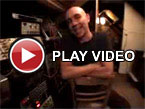 Tim Hecker's second outing on the Substractif sublabel of Alien8 with a 25-minute EP of DSP and plunderphonics based on none other than my favourite rockers, Van Halen. Fennesz's treatments of The Beach Boys and the Stones are one thing, but putting the opening riff from "Ain't Talkin' 'Bout Love" (from which the EP's title is taken) through the lo-fi digital mangler, as Hecker does on "Introducing Carl Cocks", is a more unlikely idea. With Eddie's classic and beautiful riff teased slowly into a perfect granular blur, it's an outstanding track, though what it has to do with techno-lord Carl Cox is anyone's idea. The remainder of the tracks' samples are split between musical sources and bitter interviews, on-stage raps, and radio coverage of the band's disputes, with comprehensible titles such as "Sammy Loves Eddie Hates David" but the baffling "The Return Of Sam Snead", whose only connection with VH I know of is that he's in a load of Dead Pools with poor old Eddie.
Tim Hecker's second outing on the Substractif sublabel of Alien8 with a 25-minute EP of DSP and plunderphonics based on none other than my favourite rockers, Van Halen. Fennesz's treatments of The Beach Boys and the Stones are one thing, but putting the opening riff from "Ain't Talkin' 'Bout Love" (from which the EP's title is taken) through the lo-fi digital mangler, as Hecker does on "Introducing Carl Cocks", is a more unlikely idea. With Eddie's classic and beautiful riff teased slowly into a perfect granular blur, it's an outstanding track, though what it has to do with techno-lord Carl Cox is anyone's idea. The remainder of the tracks' samples are split between musical sources and bitter interviews, on-stage raps, and radio coverage of the band's disputes, with comprehensible titles such as "Sammy Loves Eddie Hates David" but the baffling "The Return Of Sam Snead", whose only connection with VH I know of is that he's in a load of Dead Pools with poor old Eddie.While some people view this record as a destructive fuck-you to spandex rock, I'd prefer to see it as affectionate, but in honesty neither conclusion is easily drawn. The music is more "Fennesz Plays" than V/VM, but unlike the pure tribute of Drop Nineteens' "Ease It Halen" (or the mindless cock-ragga pop mish-mash of Apollo 440's "Ain't Talkin'" cover), VH's rock bloat isn't put to one side, thanks to the soundbites of breakup bitching and egotism, and the hideous sketch of David Lee Roth on the cover. What's certain is that while Steve Albini could click his fingers and make AC/DC cool, this record is simply good clean fun for micro-fans. It isn't going to make Mark Kozelek sing "Hot For Teacher."
samples:



 Jonathan Coleclough has released several stunning albums of extended drones derived from acoustic sources, and 'Low Ground' is no exception. The sounds on this recording are surprisingly electronic; they're more digitally-veiled and alien than on Coleclough's other records. With five tracks, three of them collaborative and two solo, there's quite a bit of textural variety on this CD.
Jonathan Coleclough has released several stunning albums of extended drones derived from acoustic sources, and 'Low Ground' is no exception. The sounds on this recording are surprisingly electronic; they're more digitally-veiled and alien than on Coleclough's other records. With five tracks, three of them collaborative and two solo, there's quite a bit of textural variety on this CD. The direction of the latest five-song EP from Scott Herren as Savath + Savalas is in keeping with 2000's 'Folk Songs for Trains, Trees and Honey' in that the groundwork of electronica, sampling and live performance bleeds perfectly into each other and still gives off somewhat of an organic feel. "Rolls and Waves of Ignorance" opens the disc with a nice wash of swelling minor chords and percussion under climbing upright bass lines and melodic tenor saxophone, which weave throughout. The mood is tranquil yet somber and somewhat meditative, and, as the title may suggest, with an almost freejazz-type statement to it. "Paths in Soft Focus" grooves along nicely with some quirky keyboard and guitar arpeggiation and long bass tones which are all anchored by the solid drumming of Johnny Herndon (Tortoise, Isotope 217, A Grape Dope). One of the more splendid pieces of music I've heard lately would be "Folk Song for Cello," thanks in part to its brilliant arrangement and orchestration. Building from a plucked cello progression, acoustic guitar harmonics, accordion chords and a hammer dulcimer (!), the tune settles in to a laid-back groove of synth bass, tight drums and playful keyboard and vibe flourishes. "Decatur Queen" goes from repetitive acoustic guitar, upright bass and quietly squelching percussion to a ripping snare line that drives the tune into a full-sounding romp of rhythmic keyboards and wah guitar, complete with layers of horns while closing off the disc, "Rolls and Waves of Acknowledgement" brings the EP full-circle. This track follows the same compositional style as the opener, only more sparsely arranged and with the instrumentation of fuzz guitar, bowed strings and a fuller bass sound. Ironically enough, "Acknowledgement" sounds quite dark in comparison to "Ignorance." Way too short at just over seventeen minutes, this highly recommended EP may have you checking out the various other projects Mr. Herren has on the go at the moment (Prefuse 73, Delarosa + Asora) until another full length disc makes its way out there.
The direction of the latest five-song EP from Scott Herren as Savath + Savalas is in keeping with 2000's 'Folk Songs for Trains, Trees and Honey' in that the groundwork of electronica, sampling and live performance bleeds perfectly into each other and still gives off somewhat of an organic feel. "Rolls and Waves of Ignorance" opens the disc with a nice wash of swelling minor chords and percussion under climbing upright bass lines and melodic tenor saxophone, which weave throughout. The mood is tranquil yet somber and somewhat meditative, and, as the title may suggest, with an almost freejazz-type statement to it. "Paths in Soft Focus" grooves along nicely with some quirky keyboard and guitar arpeggiation and long bass tones which are all anchored by the solid drumming of Johnny Herndon (Tortoise, Isotope 217, A Grape Dope). One of the more splendid pieces of music I've heard lately would be "Folk Song for Cello," thanks in part to its brilliant arrangement and orchestration. Building from a plucked cello progression, acoustic guitar harmonics, accordion chords and a hammer dulcimer (!), the tune settles in to a laid-back groove of synth bass, tight drums and playful keyboard and vibe flourishes. "Decatur Queen" goes from repetitive acoustic guitar, upright bass and quietly squelching percussion to a ripping snare line that drives the tune into a full-sounding romp of rhythmic keyboards and wah guitar, complete with layers of horns while closing off the disc, "Rolls and Waves of Acknowledgement" brings the EP full-circle. This track follows the same compositional style as the opener, only more sparsely arranged and with the instrumentation of fuzz guitar, bowed strings and a fuller bass sound. Ironically enough, "Acknowledgement" sounds quite dark in comparison to "Ignorance." Way too short at just over seventeen minutes, this highly recommended EP may have you checking out the various other projects Mr. Herren has on the go at the moment (Prefuse 73, Delarosa + Asora) until another full length disc makes its way out there. 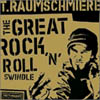 Is there too much I in your DM? Leading innovators in fun electronic dance music, Kompakt, has teamed up with the Berlin-based Shitkatapult label to release this full-lengther from Marco Haas (owner/operator of the Shitkatapult label). While it might not have the Coil-sample based tune or noise-based numbers from the recent live shows with Telefon Tel Aviv, it certainly has the fiery, raw energy that made the night F-U-N. Many readers might recognize the name from Hefty remixes or Kompakt compilations, but this release is far more deep, dark and sweaty than what might be expected from those tunes. Fuzzy digital bass and insanely punchy beats line a number of the tunes, the others are equally as fat-sounding; all are built of the stuff that makes the ass want to shake uncontrollably. (I can still even picture Marco's head bopping up and down just like Flat Eric.) Ripping the album title from an obvious punk reference, the artwork also clearly makes a stab at the punk days of stenciling. Heed the signs on the wall: this isn't a "pretty" or cute album. This is the stuff that can turn any dance floor into a seedy, sweaty meat market. Listening to songs like "Ravemusik," it seems painfully obvious that people like Chicks on Speed need to hire this German boy to make them some new beats. At only eight tracks, the album is a mighty fine treat and it's only the first of two full-length releases by Haas under the guise of T.Raumshmiere this year ('Anti' is due out in October through Hefty). Beg your local shops for this one or threaten the closest DJ shop with stink bombs if they look at you with the puppy-style cocked head.
Is there too much I in your DM? Leading innovators in fun electronic dance music, Kompakt, has teamed up with the Berlin-based Shitkatapult label to release this full-lengther from Marco Haas (owner/operator of the Shitkatapult label). While it might not have the Coil-sample based tune or noise-based numbers from the recent live shows with Telefon Tel Aviv, it certainly has the fiery, raw energy that made the night F-U-N. Many readers might recognize the name from Hefty remixes or Kompakt compilations, but this release is far more deep, dark and sweaty than what might be expected from those tunes. Fuzzy digital bass and insanely punchy beats line a number of the tunes, the others are equally as fat-sounding; all are built of the stuff that makes the ass want to shake uncontrollably. (I can still even picture Marco's head bopping up and down just like Flat Eric.) Ripping the album title from an obvious punk reference, the artwork also clearly makes a stab at the punk days of stenciling. Heed the signs on the wall: this isn't a "pretty" or cute album. This is the stuff that can turn any dance floor into a seedy, sweaty meat market. Listening to songs like "Ravemusik," it seems painfully obvious that people like Chicks on Speed need to hire this German boy to make them some new beats. At only eight tracks, the album is a mighty fine treat and it's only the first of two full-length releases by Haas under the guise of T.Raumshmiere this year ('Anti' is due out in October through Hefty). Beg your local shops for this one or threaten the closest DJ shop with stink bombs if they look at you with the puppy-style cocked head. 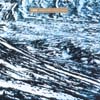 The Alternate Version of "Cake" is a reworking of Coleclough's original release: a single, 41-minute piece built mostly from processed field recordings, carefully controlled feedback, and bowed metal. It's an emotive and highly atmospheric work (if a bit linear), that spans a much wider dynamic range than his other compositions. The disc begins with recordings of birds and insects above a barely audible low-frequency rumble. This persists for several minutes at the edge of perception, occasionally augmented by footsteps, wind, and other noises captured in a peaceful landscape. Just as listening to the sounds of the forest begins to grow slightly tiresome, the piece starts moving forward, with layers of glistening, high-pitched feedback slowly emerging from the mix. The bird songs become bathed in gradually increasing amounts of reverb and effects-processing, and the rumble builds in volume and texture into a deep, ominous, metallic drone. All of the sounds used are detailed, and the resulting sum is quite interesting.
The Alternate Version of "Cake" is a reworking of Coleclough's original release: a single, 41-minute piece built mostly from processed field recordings, carefully controlled feedback, and bowed metal. It's an emotive and highly atmospheric work (if a bit linear), that spans a much wider dynamic range than his other compositions. The disc begins with recordings of birds and insects above a barely audible low-frequency rumble. This persists for several minutes at the edge of perception, occasionally augmented by footsteps, wind, and other noises captured in a peaceful landscape. Just as listening to the sounds of the forest begins to grow slightly tiresome, the piece starts moving forward, with layers of glistening, high-pitched feedback slowly emerging from the mix. The bird songs become bathed in gradually increasing amounts of reverb and effects-processing, and the rumble builds in volume and texture into a deep, ominous, metallic drone. All of the sounds used are detailed, and the resulting sum is quite interesting. Vance Orchestra releases are hard to find, spread over obscure and very small lables, beautiful designed and highly original. The orchestra are in fact a duo of Dutch musicians, who record a kind of deep listening music one can search for an eternity without a clue where to begin. This is the first full-length album I could get hold of. Packed in a fold-out miniature album sleeve (with an additional booklet full of illustrations and details), the CD clocks in at over 70 minutes with only six tracks. All of the pieces share a similar sound development and compositional evolution, mainly produced by electronics but with some added vocal snippets and bass lines. As the artwork and the titles suggest, the songs are soundtracks for time and space travel or a fictious mission in an alternative reality. Vance Orchestra are aural landscape shapers in a league of their own, only vaguely comparable to Zoviet France. The mood setting is mainly calm and atmospheric, with the exception of "Trying To Stop The Pain," which has a disturbing quality that seems to go on for too long. When everything's shut down late at night or in the early morning hours, whenever a concentrated listening is possible, 'The E Emission' is most mind-altering. Waves of memories and impressions pass on by, making it quite easy to get lost in thoughts while this music permanently feeds the subconscious. There is a love for details and a constructive force behind the music which makes this CDR both a pleasure and a timeless treasure.
Vance Orchestra releases are hard to find, spread over obscure and very small lables, beautiful designed and highly original. The orchestra are in fact a duo of Dutch musicians, who record a kind of deep listening music one can search for an eternity without a clue where to begin. This is the first full-length album I could get hold of. Packed in a fold-out miniature album sleeve (with an additional booklet full of illustrations and details), the CD clocks in at over 70 minutes with only six tracks. All of the pieces share a similar sound development and compositional evolution, mainly produced by electronics but with some added vocal snippets and bass lines. As the artwork and the titles suggest, the songs are soundtracks for time and space travel or a fictious mission in an alternative reality. Vance Orchestra are aural landscape shapers in a league of their own, only vaguely comparable to Zoviet France. The mood setting is mainly calm and atmospheric, with the exception of "Trying To Stop The Pain," which has a disturbing quality that seems to go on for too long. When everything's shut down late at night or in the early morning hours, whenever a concentrated listening is possible, 'The E Emission' is most mind-altering. Waves of memories and impressions pass on by, making it quite easy to get lost in thoughts while this music permanently feeds the subconscious. There is a love for details and a constructive force behind the music which makes this CDR both a pleasure and a timeless treasure.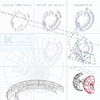 Here is a beautiful work by two artists who have different approaches to working with sound, but collaborate well. David Myers works with feedback-based sounds through various devices he has built, including a "feedback machine" I've seen him wear during live performances. (Suspended in front of his belly from a strap around his neck, he looked much like a cigarette girl from the 1930s.) Asmus Tietchens is not known to perform live, unless he's simply playing a recording of something composed in the studio. It seems his style is to take a sonic idea or source material, and go into the studio and work it for the length of an album (or double album). So you can pick up most any Tietchens CD or record, and hear a similarity between the pieces as he explores the many possibilities of his initial concept.
Here is a beautiful work by two artists who have different approaches to working with sound, but collaborate well. David Myers works with feedback-based sounds through various devices he has built, including a "feedback machine" I've seen him wear during live performances. (Suspended in front of his belly from a strap around his neck, he looked much like a cigarette girl from the 1930s.) Asmus Tietchens is not known to perform live, unless he's simply playing a recording of something composed in the studio. It seems his style is to take a sonic idea or source material, and go into the studio and work it for the length of an album (or double album). So you can pick up most any Tietchens CD or record, and hear a similarity between the pieces as he explores the many possibilities of his initial concept.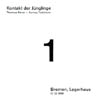 According to
According to  Recorded inside of a ship in Germany in 2001, this 42-minute piece is sometimes very quiet, with bursts of static and sounds like gurgling water. Elsewhere it has many layers of distinct sounds from drones to gently crackling static. There's a nice range from low to high frequencies and from droning to beeping/chirping sounds, with the overall feeling of something building in intensity, gently subsiding, then regaining strength in several waves. I knew nothing of Thomas Köner before hearing these two Kontakt der Jünglinge CDs, so by checking his web site (http://www.koener.de) I was not surprised to learn he started as a composer for film. From what I know of Asmus Tietchens, he does not often perform live, as he's primarily a studio-based composer. I would have been curious to learn what equipment he used in this performance, if any. Or did he just play prerecorded bits?
Recorded inside of a ship in Germany in 2001, this 42-minute piece is sometimes very quiet, with bursts of static and sounds like gurgling water. Elsewhere it has many layers of distinct sounds from drones to gently crackling static. There's a nice range from low to high frequencies and from droning to beeping/chirping sounds, with the overall feeling of something building in intensity, gently subsiding, then regaining strength in several waves. I knew nothing of Thomas Köner before hearing these two Kontakt der Jünglinge CDs, so by checking his web site (http://www.koener.de) I was not surprised to learn he started as a composer for film. From what I know of Asmus Tietchens, he does not often perform live, as he's primarily a studio-based composer. I would have been curious to learn what equipment he used in this performance, if any. Or did he just play prerecorded bits? 